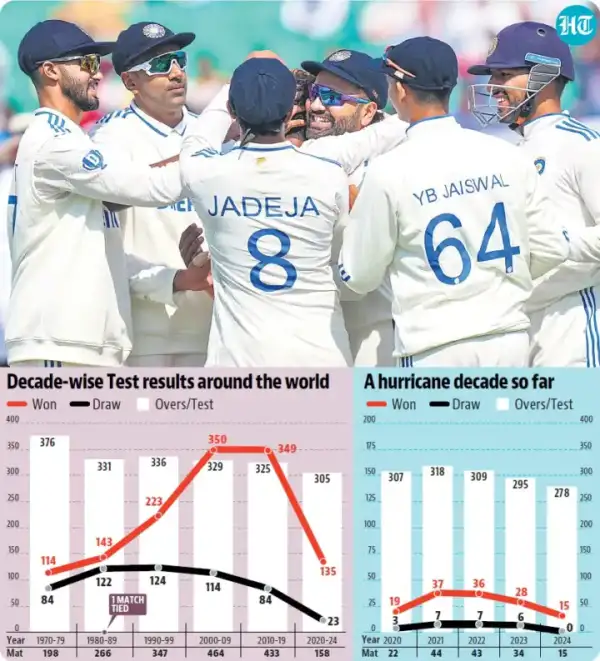
Test affair: In 2024, draws have gone out of fashion
Dharmendra2 kumar
getcricketnews|12-03-2024
This has been a rare year where each of the 15 Tests played so far have yielded results, 11 of them in four days, three within three days and the New Year's Test involving India at Cape Town producing the shortest completed match ever-lasting 656 balls across just two days.
It can't be coincidental that this year has also witnessed India's biggest ever Test win, or that this decade has already produced three of the 10 shortest ever completed Test matches, none of the other seven coming after 1935. In short, Test cricket is becoming shorter, and draws are going out of fashion at breakneck speed. The slide wasn't exactly drastic till this decade. Traditional form of cricket had largely gone untouched till the 1970s when the one-day format started gaining more traction with two World Cup editions. Still, the average duration of Test matches during this decade was 376 overs, translating to just over four days of cricket. It was only in the 1980s that the influence of one-dayers became markedly visible, with the average duration decreasing to 331 overs per Test, a change also probably brought upon by the increasing tours of the subcontinent where spinners could run through sides within sessions. That the average duration of Tests didn't fluctuate much through the next three decades-336 overs in the 90s, 329 overs in the 2000s and 325 overs in the 2010s-can be more or less attributed to the emergence of some of the finest ever Test batters who could hold forte against great fast bowlers and spinners on even the most devious of pitches. This was also perhaps the most balanced phase in the history of the game, witnessing the emergence of a strong post-Apartheid South Africa, the slow disintegration of West Indies, Australia putting together two of the greatest winning streaks ever, Sri Lanka and New Zealand building an enviable home record, Pakistan beginning to win more consistently in England, and India expanding on their home invincibility by registering series wins in England and Australia.
Latest Newsmore

Josh Inglis Added To CA XI Squad For Four-day Clash Against England Lions
20-Nov-2025 • CricketnMore

'LSG is still backing me' - Mayank Yadav reflects on support from franchise ahead of IPL 2026
20-Nov-2025 • CricTracker

Ashes 2025-26: Steve Smith fires back at Monty Panesar over Sandpapergate remarks
20-Nov-2025 • CricTracker

Watch: Sanju Samson Makes CSK Debut In Iconic Yellow Ahead Of IPL 2026
20-Nov-2025 • ABP Live Sports

Star batter returns after six years as West Indies announce squad for New Zealand ODI series
20-Nov-2025 • Srijal Upadhyay





